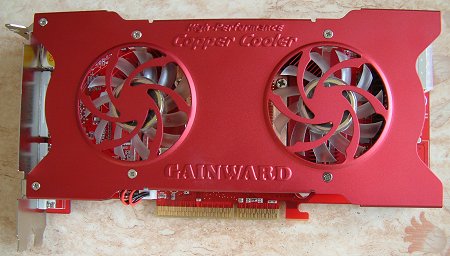Appearance and thoughts

Feel free to click on the picture for a larger image. Gainward's really gone to town with its 6800 GT GLH card's design. Striking and individual looks never hurt. Gainward's of the opinion that the best method of cooling a 400MHz NV40 core is by using a large copper heatsink that's got a couple of fans suspended above it.

A side-on picture reveals all. The height of the CopperCooler contraption forces the 6800 GT GLH into a two-slot design. Gainward maintains that GLH Golden Sample cores are hand-selected from the very best TSMC has to offer. If that's the case, Gainward has put an awful lot of emphasis on cooling, suggesting that the supplied cores don't quite meet up to Ultra standards.

Taking away the cooling appendage shows a slab of finned copper covering the core. 4 screws connect to a holding plate on the back of the card. It's worth noting that the screws aren't fully tightened on purpose. Doing so forces the 10-layer PCB to flex significantly. The AGP connector also begins to bend heavily. Removing the chunk of copper reveals a regular GeForce 6800 GT core. Gainward, therefore, has simply chosen the better GT cores, added in some extravagant cooling, and felt confident enough to ratify them at 400MHz.

Turning the anodised aluminium appendage over shows a couple of EVERCOOL fans, model number EC6010H12C-CL. EVERCOOOL's literature contends that both fans push out around 18CFM each, and produce less than 29dBa whilst doing so. Gainward's EXPERTOOL software allows for fan-speed manipulation, based on either dynamic or fixed settings. I found the cooling to far louder than a normal 6800 GT's when set to maximum speed. Running the fans at, say, 60% resulted in, this reviewer's ears' opinion, about the same level and pitch of sound as a reference GeForce 6800 Ultra's single fan. Gainward's GLH is certainly no NV30-like Dustbuster, but neither can it be termed quiet unless used at the very lowest setting.

A head-on look at the front shows just how the fans are suspended over the copper block. Also note that, in line with other GeForce 6800 GTs, there's only a single molex connector. Ultra variants ship with two, which goes to show that NVIDIA's reference Ultra cards were, perhaps, destined to launch at 450MHz instead of present 400/425MHz. Hidden under the trademark deep-red RAMsinks is 256MBs of 1.6ns GDDR3 RAM that's specified to run at a blistering 1200MHz; 100MHz higher than most Ultra's defaults, so the Ultra/2400 GLH GS will be faster than the vast majority of Ultra-based cards when run with the enhanced settings. 38.4GB/s of potential bandwidth just sounds plain rude and fast.

Another Ultra import is the use of dual DVI interfaces. It's a sensible inclusion that's based on the increasing number of enthusiasts who run 2 DVI-capable TFTs. Of course, using either or both as regular HD15 connections is simply a matter of using a DVI-to-VGA dongle, of which Gainward supplies two. Some day all premier cards will sport dual DVI. A lack of video-in processing means that the S-Video port is only useful for outputting video streams.
Gainward has taken a basic GeForce 6800 GT and given it a Goes Like Hell makeover. That's resulted in a guaranteed core frequency around 14% higher than most GT's and memory that purrs along at 20% above a GT's default 1000MHz. In fact, had Gainward hardwired the enhanced clocks via a suitable board BIOS we'd be saying this card's an Ultra-beater in every respect. That's not too shabby for a supposed GT model, is it?.









